Article summary
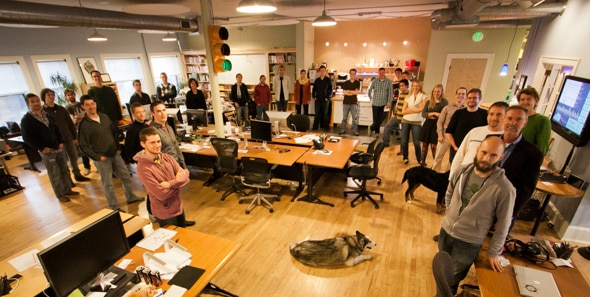
When companies are very small, internal communication happens pretty naturally. You all work closely together, sharing a small space and a small number of projects, so it’s pretty easy to keep up on the news without even trying.
But the larger a company gets, the less you can take internal communication for granted. Atomic now has over 40 employees — five in Detroit and the rest split between two floors at our Grand Rapids office. We do enough projects that two people could be at Atomic for years without ever being on the same team. And since we no longer share one kitchen/snack area, and we certainly can’t all fit around one table at the Meanwhile anymore, it’s very difficult to know all of your fellow Atoms and keep tabs on what going on across the company. Because Atomic takes its culture and its commitment to transparency very seriously, this is a problem.
Internal Communication Methods
Atomic tackles the problem with several communication tools/methods, most unofficial and crow-sourced.
Daily Standup
Ever day, each of our offices holds a short standup meeting, promptly at 9, to announce guests, promote events, praise each other for jobs well done, etc. (See the photo at the top of this post for an example of how it looks.) Here are ten reasons why.
Quarterly Company Meeting
Every quarter, Atomic’s leadership brings employees and their spouses/partners together for a company meeting. They share financial results for the quarter (including our Profit & Loss Statement), discusses plans for the months to come, and answers questions. Afterward, Atomic treats everyone to dinner.
Open, Flexible Space
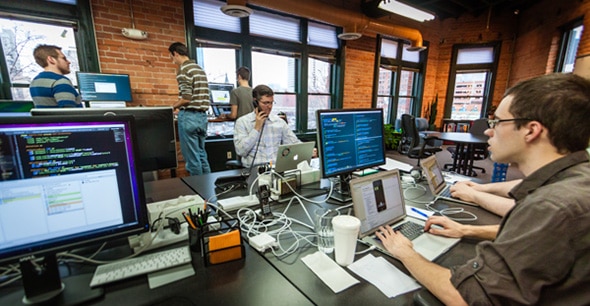
No “communication channel” can replace actual, face-to-face conversation, so we work in open offices without walls or cubicles. Atomic’s offices are busy, friendly places, full of tech-talk and shared jokes. This helps us build and share our culture naturally.
Because we all sit so close together, it’s also easy to teach and learn. Atoms are curious, and we all love to learn about and learn from each other’s projects. And when a team breaks up and its members move to join other teams, that new knowledge goes with them, spreading ideas around the company.
Atomic Wiki
Where most companies have an employee handbook, Atomic has an employee-created, employee-maintained wiki. It holds (among other things) specs on client and internal software, information about internal projects, educational material, and lots of other company information. Our wiki was created in 2002 using Foswiki. It currently has over 900 pages.
Mass Emails
This is a great way to have a conversation between employees who can’t all meet at the same place and time. When someone at Atomic wants to start a company-wide discussion, usually about a non-technical topic (How should we phrase our newest value mantra? How long should we require people to be at Atomic before joining the ESPP program?), they start an email discussion. These inevitably spill out into the real world, often in the form of a company-wide lunch discussion.
Atoms are passionate people, and these email conversations can get passionate too, but I’ve been impressed by how respectful people at Atomic are, even when they strongly hold different opinions.
Brown Bag Lunches
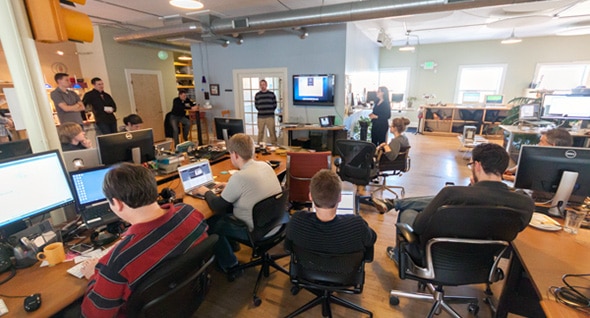
When someone has a lesson or tool they want to share, or a topic they want to discuss, they schedule a brown bag lunch. All it takes is sending out an invitation and reserving a room on the shared calendar. Interested Atoms bring their lunches and meet between noon and 1 p.m. for a low-key presentation or discussion.
Monitors & Information Radiators
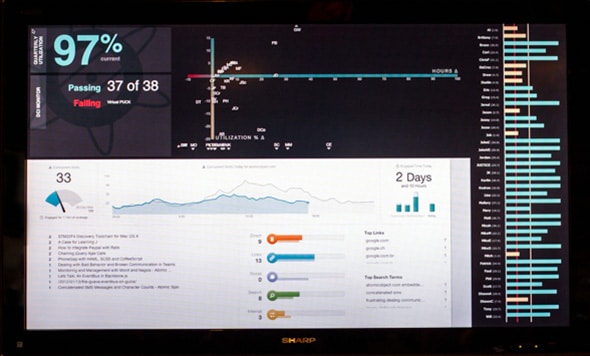
Atomic shares data about projects and employees with several information radiators. There’s a continuous integration monitor, which shows the status (failing, building, or passing) of all current projects. There’s a server monitor that displays data on internal and client servers and infrastructure using Zabbix. And there’s a television (shown above) that shows three kinds of data:
- A scatter plot tracking each employee’s performance along two Key Performance Indicators: the x-axis showing the number of total hours worked and the y-axis showing % billable utilization.
- A bar chart showing the number of days left until each employee’s Spin post is due. Bars turn yellow when the post is due in under a week, then turn red when the post is overdue.
- A snapshot of current website and blog performance data taken from our Chartbeat dashboard.
Yammer
Since late 2009, Atomic has a free, company-wide social network on Yammer. Most of the activity is employees:
- sharing interesting articles, videos, and websites (some work-related, some just entertaining),
- discussing company resources (checking books out of the Atomic library, asking about missing power cords, etc.), and
- posting reminders/questions about company or company-sponsored events.
No essential information is distributed through Yammer, but it’s a great way to spread culture and ideas between offices and teams.
Basecamp
Basecamp is an online project management tool we use to communicate and collaborate with clients. A project’s Basecamp becomes a centralized archive of all communication related to a project, including files (design artifacts, etc.) that need to be shared. Whenever possible, team members start Basecamp discussion threads rather than emailing, because email gets lost in someone’s account and can’t be easily shared with new members. Basecamp also has the functionality to add lightweight todo lists and notes files.
Basecamp is also used to manage and centralize communication for internal projects, e.g., a new website or a coordinated speaking effort.
Pair Lunches
In 2012, Atomic began paying for employees to have lunch together. The goal was to help build relationships between people who wouldn’t otherwise have an opportunity to get to know each other, and it’s been a great success. You can read more about pair lunches in Carl’s recent post: “Pair lunch: an inexpensive, effective benefit to strengthen company bonds.”
Design Series
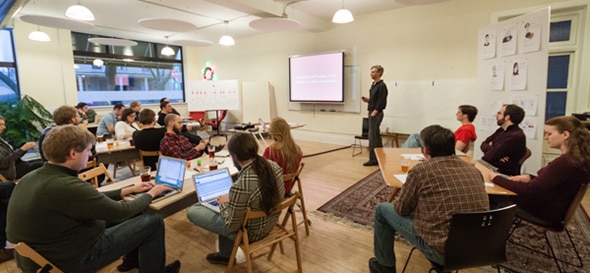
To help ideas spread throughout the company faster, Shawn Crowley organized the Atomic Design Series last year, with six months of presentations and workshops on design topics that affect all employees (Data Visualization, The Design of Business, Innovation Games, etc.).
You can read more about the series in Shawn’s recent article, “Cross-Pollinating Innovation Across the Organization.”
Atomic Nucleus e-Newsletter
The channels described so far help employees spread our culture, discuss projects, and learn new skills, but they rarely cover the business side of Atomic. To fill that gap, we recently started a bi-weekly email newsletter called the Atomic Nucleus. It includes:
- Announcements
- A List of Upcoming Events
- Team Updates (which projects are starting/ending, which employees are moving between projects, etc.)
- A List of Pending Sales Opps
- A Short Description of one Current or Recent Project
I create and distribute the Atomic Nucleus using MailChimp. When I conducted a readership survey last month, over 90% of respondents said they read at least 3/4 of each issue.
Conclusion
These internal communication channels work well together because each serves a different need. When combined, they keep culture and information flowing through Atomic Object.
Does your company use other methods that you think Atomic could learn from? Do you use any of the methods described above in different ways? We’d love to hear about it.
